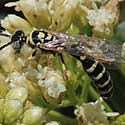Desert Broom
Baccharis sarothroides

The swelling in the stem of the Desert Broom is a gall caused by minute insects. Near the center of the gall are a dozen or more cecidomyiid fly larvae.
On fresh new growth these galls may be abundant. They are soft and easy to
break open revealing small orangish larvae of gall midges inside.  A fresh gall may
contain 20 or more. Eventually adult
Gall Midges, similar to the one at left, emerge. Later the galls harden
and may remain on the plant for many seasons, but without occupants.
A fresh gall may
contain 20 or more. Eventually adult
Gall Midges, similar to the one at left, emerge. Later the galls harden
and may remain on the plant for many seasons, but without occupants.
The flies release an irritating substance into the plant tissue and in response the plant produces a durable home containing the fly's food. But the gall midges are heavily parasitized by small wasps whose search for prey may be aided by the swelling?
Many insects live upon desert broom especially during periods of rapid vegetative growth - e.g. after summer rains. Boldt et. al 1989 (Proceedings of the Entomological Society of Washington, Vol. 90, no. 2, pp. 207-215.) recorded 64 species of herbivores on Desert Broom in Arizona and New Mexico.

Dictyna spiders take advantage of this prey abundance. The silk has a very white appearance due to its light-scattering, microscopic, hackled structure; the web is typically constructed near the top growing points where prey are most abundant.
Desert Broom's flowering period in mid October offers an abundance of nectar and pollen: Read More.



